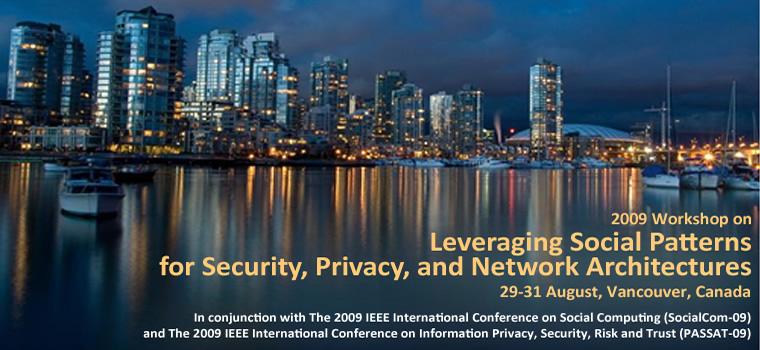Workshop Overview and Motivation
Recent years have seen an explosion of social applications on the Internet. However, most of these works remain at the end-user and application levels: applications that reside within specific websites like Facebook, or ones that link social information between other applications - like instant messaging, blogs, web browsers or email clients. Aside from nascent work on areas such as routing and security filters, so far few have ventured into taking the social information down to the lower layers of the network stack.
Most existing communication network architectures are agnostic to the structures and behaviors of the human networks that they serve. We believe that by incorporating social patterns into the network protocols we will be able to significantly improve the network security, privacy and quality of service levels, by producing protocols that are auto-adaptive to the social aspects of their users’ network behaviors. It is predicted that by 2017 we will be interacting with over 1000 devices in our daily lives, where social information would be crucial for every connection we make. Utilizing social information at the level of networking can facilitate the building of systems and applications of higher reliability, efficiency, and usability.
The workshop aims to bring to the forefront two intertwined approaches that involve the use of social information and social modeling for networking, privacy and security applications:
The first approach is the creation of network architectures and network devices that are aware of the interpersonal networks and relationships of the end-users. Communications networks, especially at scale, are quite complex systems. Most network protocols are made to be extremely flexible, offering dozens of configurable parameters like counters, time-outs, packet and payload sizes, bit rates, or error correction settings. However, this flexibility is commonly underutilized, and most of these values are pre-configured with default values. Social information could be used to configure sets of parameters that represent the users' trust and relationship settings. For example - setting quality of service (QoS) settings in a corporation according to the internal hierarchy, or allowing a family's devices to recognize and trust the devices owned by its members, and configure firewall and security settings accordingly. Another example might be that a device would automatically turn on encryption when communicating with a co-worker, but not use it when interacting with devices that belong to friends or family. Sensing ‘stranger’ devices in the vicinity might cause a social group’s devices to turn on encryption. Social information might even be useful in the physical layer, in the context of cognitive radios. If a cognitive radio would be aware of the relationships of its owner, for example be able to recognize the devices of the owner’s family members, these devices could coordinate a frequency hopping sequence of their own, improving performance and security.
The second approach is building network architectures that are inspired by the way human networks and human society works. In order to achieve the ambitious goals of self-organizing and distributed management of networks, we turn to learn from existing systems that present very similar characteristics to some degree or other – human society. Our approach is to improve the usability of networked devices by modeling their functionality and behavior after observations from the human social realm. Community formation, retention, evolution and growth models can be used for designing networks for scalability, extensibility and fluidity.
In order to achieve these goals and to eventually deploy real-world systems using these principles, we need to create a common language between the researchers and practitioners of this new area - spanning from the social modeling side to the networking and engineering side. We need interfaces to make use of learned social models and apply them for configuring network protocols. From the other end, we want to utilize network logs from different layers for inferring social information and feed it as input for social learning and modeling. We want to be able to create large scale experimental platforms for investigating the different possibilities, both in the lab and in the field.
